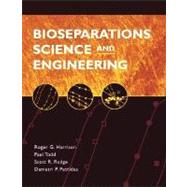
What is included with this book?
| Preface | |
| All chapters (except Chapter 12) end with the following sections: Summary, Nomenclature, Problems, and References | |
| Preface | |
| Introduction to Bioproducts and Bioseparations | |
| Instructional Objectives | |
| Broad Classification of Bioproducts | |
| Small Biomolecules | |
| Primary Metabolites | |
| Secondary Metabolites | |
| Summary of Small Biomolecules | |
| Macromolecules: Proteins | |
| Primary Structure | |
| Secondary Structure | |
| Tertiary Structure | |
| Example | |
| Effect of a Reducing Agent on Protein Structure and Mobility | |
| Quaternary Structure | |
| Prosthetic Groups and Hybrid Molecules | |
| Functions and Commercial Uses of Proteins | |
| Stability of Proteins | |
| Recombinant Protein Expression | |
| Macromolecules: Nucleic Acids and Oligonucleotides | |
| Macromolecules: Polysaccharides | |
| Particulate Products | |
| Introduction to Bioseparations: Engineering Analysis | |
| Stages of Downstream Processing | |
| Example | |
| :Initial Selection of Purification Steps | |
| Basic Principles of Engineering Analysis | |
| Process and Product Quality | |
| Criteria for Process Development | |
| The Route to Market | |
| The Chemical and Applications Range of the Bioproduct | |
| Documentation of Pharmaceutical Bioproducts | |
| GLP and cGMP | |
| Formulation | |
| Analytical Methods | |
| Instructional Objectives | |
| Specifications | |
| Assay Attributes | |
| Precision | |
| Accuracy | |
| Specificity | |
| Linearity, Limit of Detection, and Limit of Quantitation | |
| Range | |
| Robustness | |
| Analysis of Biological Activity | |
| Animal Model Assays | |
| Cell-Line-Derived Bioassays | |
| In Vitro Biochemical Assays | |
| Example | |
| :Coupled Enzyme Assay for Alcohol Oxidase | |
| Analysis of Purity | |
| Electrophoretic Analysis | |
| Example | |
| :Estimation of the Maximum Temperature in an Electrophoresis Gel | |
| High Performance Liquid Chromatography (HPLC) | |
| Mass Spectrometry | |
| Coupling of HPLC with Mass Spectrometry | |
| UV Absorbance | |
| Example | |
| :Determination of Molar Absorptivity | |
| CHNO/Amino Acid Analysis (AAA) | |
| Example | |
| :Calculations Based on CHNO Analysis | |
| Protein Assays | |
| Enzyme-Linked Immunosorbent Assay | |
| Gas Chromatography | |
| DNA Hybridization | |
| ICP/MS (AA) | |
| Dry Weight | |
| Microbiology Assays | |
| Sterility | |
| Bioburden | |
| Endotoxin | |
| Virus and Phage | |
| Cell Lysis and Flocculation | |
| Instructional Objectives | |
| Some Elements of Cell Structure | |
| Prokaryotic Cells | |
| Eukaryotic Cells | |
| Cell Lysis | |
| Osmotic and Chemical Cell Lysis | |
| Mechanical Methods of Lysis | |
| Flocculation | |
| The Electric Double Layer | |
| Example | |
| :Dependence of the Debye Radius on the Type of Electrolyte | |
| Forces between Particles and Flocculation by Electrolytes | |
| Example | |
| :Sensitivity of Critical Flocculation Concentration to Temperature and Counter-Ion Charge Number | |
| The Schulze-Hardy Rule | |
| Table of Contents provided by Publisher. All Rights Reserved. |
The New copy of this book will include any supplemental materials advertised. Please check the title of the book to determine if it should include any access cards, study guides, lab manuals, CDs, etc.
The Used, Rental and eBook copies of this book are not guaranteed to include any supplemental materials. Typically, only the book itself is included. This is true even if the title states it includes any access cards, study guides, lab manuals, CDs, etc.